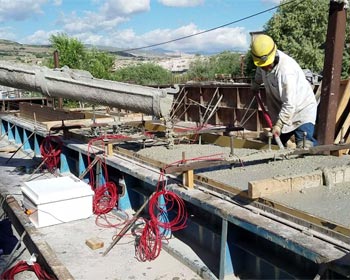MPC Research Reports
Report Details
Abstract
 Calcium sulfoaluminate (CSA) cement was used to cast a prestressed voided deck slab bridge girder. The rapid-set properties of CSA cement allowed the initial concrete strength to reach the required 4300 psi needed in order to cut the prestressing strands 6.5 hours after casting. Prestress losses were monitored long term using vibrating wire strain gages cast into the concrete at the level of the prestressing strands, and the data were compared to the American Association of State Highway and Transportation Officials Load and Resistance Factor Design (AASHTO LRFD) predictions for prestress losses. AASHTO methods for prestress loss calculation were overestimated compared with the vibrating wire strain gage data. Material testing was performed to quantify material properties, including compressive strength, tensile strength, static and dynamic elastic modulus, creep, and drying and autogenous shrinkage. The material testing results were compared with AASHTO predictions for creep and shrinkage losses.
Calcium sulfoaluminate (CSA) cement was used to cast a prestressed voided deck slab bridge girder. The rapid-set properties of CSA cement allowed the initial concrete strength to reach the required 4300 psi needed in order to cut the prestressing strands 6.5 hours after casting. Prestress losses were monitored long term using vibrating wire strain gages cast into the concrete at the level of the prestressing strands, and the data were compared to the American Association of State Highway and Transportation Officials Load and Resistance Factor Design (AASHTO LRFD) predictions for prestress losses. AASHTO methods for prestress loss calculation were overestimated compared with the vibrating wire strain gage data. Material testing was performed to quantify material properties, including compressive strength, tensile strength, static and dynamic elastic modulus, creep, and drying and autogenous shrinkage. The material testing results were compared with AASHTO predictions for creep and shrinkage losses.
The bridge girder was tested at midspan and a distance 1.25 times the depth of the beam from the face of the support until failure. Midspan testing consisted of a crack reopening test to solve for the effective prestress in the girder and a test until failure. The crack reopen effective prestress was compared with the AASHTO prediction, and AASHTO appeared to be effective in predicting losses based on the crack reopen data. The midspan failure was a shear failure, as accurately predicted by AASHTO. The 1.25d test resulted in a bond failure, which was accurately predicted by the AASHTO bond model for prestressed concrete.
How to Cite
Markosian, Nicholas A., Robert Thomas, Marc Maguire, and Andrew Sorensen. Calcium Sulfoaluminate Cement Concrete for Prestressed Bridge Girders: Prestressing Losses, Bond, and Strength Behavior, MPC-19-401. North Dakota State University - Upper Great Plains Transportation Institute, Fargo: Mountain-Plains Consortium, 2019.

